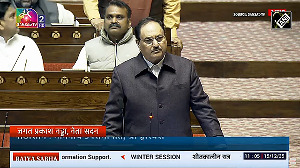As a game, cricket is a data cruncher's delight. Each game of cricket throws up loads of player-specific statistics on averages, strike rates, nature of dismissals, and so on. I have been studying the one-day international batting performance for members of the Indian cricket team over the period December 1989 (Sachin's debut game) to November 2004 (the BCCI Platinum Jubilee game). While compiling the data certain striking anomalies in the data made me sit up ... and write this article.
In cricket, the strike rate for a batsman for a particular innings is defined as (runs scored/balls faced)*100. Theoretically therefore, the strike rate for a batsman could range from zero to 600. In reality, however, the highest strike rate achieved by the cricketers under study during the period 1989-2004 was 350 by Nehra (14 runs off four balls) in the VB Series match against Australia in 2003-04.
Since a score of zero would translate to a strike rate of zero irrespective of the number of balls faced, the most frequent strike rate for a batsman is likely to be a strike rate of zero. But, what would you expect to be the probability of a batsman getting a strike rate of 100, or 50, or any other figure other than zero for that matter? Very low, it would seem. For instance, in the 47 matches that Harbhajan Singh has batted in during this period, he has had a score of zero (and therefore, a strike rate of zero) in six of these matches. So the probability of Harbhajan getting a strike rate of exactly 100, or 50, or any other figure in the remaining 41 matches should be very low, given the fact that the strike rate can range anywhere from zero to 167 (167 is Harbhajan's highest strike rate during this period).
But think again! Ignoring strike rates of zero, the most occurring strike rate (the "mode" of the frequency distribution in statistical language) for Harbhajan in these 47 matches has been 50. He has had a strike rate of 50 in six of the 47 matches. And that is not all! The next most occurring strike rate for Harbhajan ("the near mode", shall we term it?) has been 100. He has had a strike rate of 100 in four of the 47 matches. That means that Harbhajan has had a strike rate of 50, or of 100, in 21.28 per cent (10 of the 47) matches that he has played during this period. It's not just Harbhajan, for almost every single batsman covered in the analysis, a strike rate of 50, or of 100 is either the mode or "near mode".
The columns in the table can be explained using Harbhajan's data. The second column shows that his highest strike rate has been 167 (15 runs off nine balls against Zimbabwe in 2001-02). Of the 47 matches, Harbhajan has had a strike rate of zero in six matches, 50 in six matches, 100 in four matches, 60 in three, 86 in three, 54 in two, 88 in two and 116 in two. In the remaining 19 matches he has had various strike rates (for instance, 17, 38, 83, 110, 140, 167) once each. So, the third column (rank for strike rate of 50) shows that for Harbhajan a strike rate of 50 has been -- jointly in this case with a strike rate of 0 -- been the most occurring strike rate, occurring six times out of the 47 matches he has played in. The fourth column (rank for strike rate of 100) shows that for Harbhajan a strike rate of 100 has been the second most occurring strike rate, occurring four times out of the 47 matches he has played in. The last column shows that the probability of Harbhajan getting a strike rate of exactly 50 or 100 is 21.28 per cent.
The collective data shows that during the period of study, Indian ODI cricketers seem to have an inexplicable affinity for strike rates of exactly 50 and 100. This is the amazing thing about this analysis: why don't cricketers score at strike rates of 45 or 59 or 95, or 98 or 102 or 105 as frequently as they score at the strike rates of exactly 50 and 100?
The incentives cannot be monetary. Is it then the romantic charm associated with a run-a-ball strike rate that is sub-consciously playing on players' minds? But even then, this would explain only half the anomaly (the 100 strike, not the 50). Or akin to the Sensex, is there a Crickex effect at play here? Just as the stock market is believed to have a fascination for "round" benchmarks such as 8,000 or 8,500, do cricketers have a fascination for "round" strike rates? Or am I missing out on some obvious features of the underlying run-generating process in cricket that makes the likelihood of strike rates of 50 and 100 more likely? Or is it that I have cheated by rounding off strike rates to the nearest integer? (I have rounded off the strike rates but not with the intention of cheating!) Or should we be plain superstitious and (just as umpire David Shepherd does on the dreaded Nelson score of 111) take our feet off the ground each time a batsman is on a strike rate of 50 or 100?
As of now, a solution to this riddle of human behaviour and incentives eludes me!
The author is a member of the Finance Faculty at the XLRI Jamshedpur School of Management.







